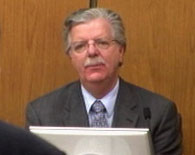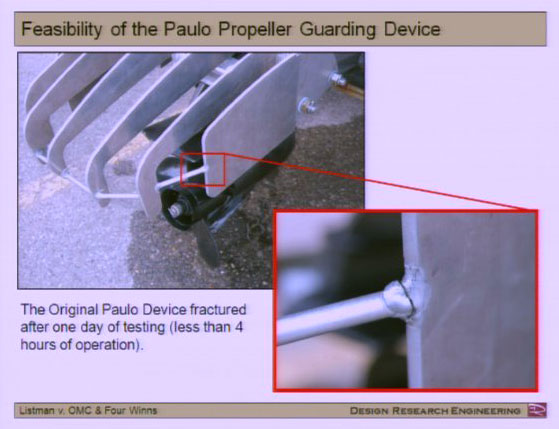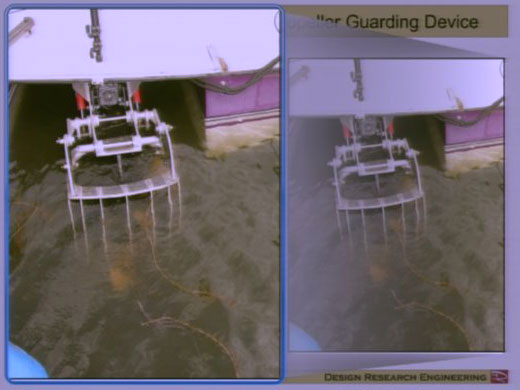Listman trial 17 November Session 1b
This post is part of our coverage of the Listman v. OMC propeller injury trial
Robin Listman vs. Outboard Marine Corporation
Second Judicial District Court of the State of Nevada, County of Washoe
17 November 2011 Session One
Our coverage was obtained via a video feed supplied by Courtroom View Network (CVN). The images are also courtesy of CVN.
This session focused on boat testing performed by Robert Taylor at Design Research Engineering.
Testimony was heard from:
- Robert Taylor – an expert witness for the defense
We heard from two attorneys:
- Jay O’Sullivan for OMC
- Bill Jeanney for Listman
Robert Taylor
Cross Examination of Robert Taylor by Bill Jeanney
Jeanney basically started going through each of problems Robert Taylor said he identified with the guard and tried to show they were trivial or non existent.
Pitot tubes, What testing did you do to see at what frequency that this would happen (become clogged or need cleaned)? Taylor does not have a likely frequency for it.
Inadvertent Deployment of the guard, Did you test the reliability of this particular product? It came down on one occasion.
In about 100 tests it came down once? 99 runs out of 100 with no unintended deployment? Yes.
Jeanney showed the photo of the fractured tine on prototype 1 again. You tested prototype 2 similarly and it did not fail? Correct. Weeds, you showed the weed photo earlier. You could just raise the guard? Yes.Stern drives can collect weeds? Yes…
Skippiness in hard right turn, Yes at higher speeds. You had the capability to measure that? Yes.
Taylor agreed the skippiness was not of the nature to throw anybody out.
Jeanney, It did not create a danger? No.
Jeanney you are no stranger to a courtroom. In 2009 you said you had been in 65-70 courtroom trials and given 300 depositions. Plus since then? This might be my 5th trial this year.
All of them in boating? Yes.
All of them defending boating corporations? Yes.
Jeanney, Failure Analysis became the largest firm in the U.S. in that area? Yes.
Primary money maker at Failure Analysis was accident reconstruction, defending corporations, Ford, GM, Exxon, and Tobacco companies. They had a staff of 400 engineers.
Jeanney began to identify some of Taylor’s clients and those of Failure Analysis that the jury might not think about him defending.
GMC in a side tank collision (the 20/20 or Dateline case with fraud on the part of the media), Exxon in the Exxon Valdez case.
In your 15 years at Failure Analysis did you find them to competent and trustworthy? Yes, but that does not mean I have complete knowledge.
Now at DRE are your clients typically corporations like OMC, Mercury? The majority are.
What others have you worked for in the last 15 years at DRE? Yamaha, Sea Ray, Checkmate, Ranger, Boston Whaler.
You have worked on PWCs? Yes.
They are jet powered and there is no prop? Yes
You can’t reach in and touch the impeller? No.
You have testified that that is a safe design in the PWC field? Yes.
You have had about 1,000 projects? Yes.
How much are you charging OMC per hour? $285.
You came into town Monday night, you had the opportunity to meet with OMC lawyers and discuss your testimony?
You prepared your exhibits? Yes, I always prepare my own exhibits.
Since Monday night you are billing for? For the time I work.
Are you billing for the time you are anticipating getting on the stand? Yes.
You became involved with OMC in the early 1980’s? Yes.
Alex Marcone (OMC’s in house legal counsel at that time) at OMC was your first contact there? Yes.
He contacted you about working for OMC in a case in which prop guarding was an issue? Yes.
Do you remember the name of that case? No.
You have been repeatedly retained by OMC in propeller cases? Yes.
They are being sued, that’s the project yes? Yes.
In 1980-2011 you testified in OMC’s behalf in excess of 10 times.
In 1980s’ maybe 4 trials, 1990’s none, 2000 to now this is the 3rd.
You also testified for Mercury in that time frame for prop cases? Yes.
What other manufacturers retained you in litigation on prop cases? Yes for a few other boat manufacturers but not other engine manufacturers – oh yes, there was Yamaha.
So you have been in 10 to 15 propeller cases in court in the last 31 years? Yes.
Were you asked by OMC to participate in OMC 441? No, I was doing risk analysis.
You knew Ted Holterman? May have met, but no memory of it.
Kueny? Yes, I have known him for 30 years. He was an engineer at OMC.
Did OMC ask you to participate in test 443? No.
In regards to O’Sullivan have you been involved with him previously? Yes, two cases, Decker and Ah-Fook.
You were retained in this case in 2008? Yes. We ran a test no instrumented, then instrumented, then biomechanical testing. Plus the guys took the boat out a few times to debug the control system.
What have you billed OMC to date on this case? I don’t know.
Jeanney, We have copies of a series of invoices to O’Sullivan’s firm all related to you and your company’s work. They total over $216,000 (Jeannet provided the exact total).
Yes, it might have been in that range.
May 2008 testing was about $93K and you ran another similar set of tests on the second prototype, it could now be close to $300K.
You billed the Decker case as $75 to $100K, Ah-Fook billed at close to $100K
Plus the Bell case (the MasterCraft case) is over $200K? Yeah.
You billed over $1 million for PWC work? Yes.
Jeanney did some speculating about averaging some of these big ones, then reducing the average by half, and spreading it over 1,000 cases.
OMC Counsel, The Plaintiff is badgering the witness.
Taylor, Yes I have 30 people, look at the value of our testing, it all takes time, effort, and energy, and I bill for it.
Jeanney, You have been to Canada, Greece, Netherlands, South Africa, (he also listed some other countries I missed)? Yes.
You have never been requested, outside of litigation to design a guard? Right.
Have you ever been given an outline, an acceptable performance criteria for OMC? No.
At Ah-Fook, Kueny was involved? Yes.
At Decker, Kuney was involved? Yes.
Kueny is in this one? Yes.
Mr. Sullivan did not provide you with Mr. Kueny’s deposition in this case right?
Taylor was starting to look for it, and the Judge called for the morning 15 minute break.
Jeannet was insinuating that Taylor already knew how Kueny was going to testify so he did not even have to review his deposition. He knew how Kueny was going to testify because they just keep giving the same testimonies over, they don’t really analyze the case (per the insinuation).
Sawbones leg testing, you were present and saw the video?
Objection.
Jeanney, The issue is what was done to prevent radial strikes? If there is a physical barrier that’s a good thing? In that one circumstance it (the guard) may be a benefit, but the likelihood of radial entry is almost nonexistent.
Jeanney, People could have been moving that way (approaching prop from the side)? Yes.
A barrier would prevent a disabling injury? Sure.
Jeanney, earlier you talked about the transom propeller warning decal that said the engine should be stopped? During the 1980’s Failure Analysis published peer reviewed papers on the effectiveness of warnings? Yes.
Yesterday you were asked about the late 1980’s BSAC report? Yes. It is exhibit 20. In the 1980’s I had accident databases. As a result, I gave a presentation to the subcommittee.
You were paid to do that by OMC? Yes, they paid my direct expenses, I donated my time.
Did you tell that subcommittee anything about warnings? I don’t think warnings was a topic I was asked to present. No.
Did you volunteer it (anything about warnings to the subcommittee)? Don’t remember.
Did you provide it to OMC? No. I wasn’t doing warnings. I was doing risk analysis.
You tested guarded and unguarded Prototype 1 guard and Prototype 2 guard to measure the performance between the two yes? Yes.
Yesterday you explained some of the equipment for your testing, gps, gyro, etc. Typical consumers do not have those? Right.
Two people can drive the same boat and come to liking it or not liking the maneuverability? Right.
You were just using the data to compare the two? Right.
In 2008 you did 3 days of data taking, no accidents, no injuries, no one pinched? No, we were careful.
In 2010, more rigorous tests, no injuries, no accidents, not even bandaids?
Did you test fuel consumption? No.
Time to plane, two second difference between guarded and unguarded. One thousand-one, One thousand-two. Subjectively I may not even notice it? Taylor, Correct. To the extent are covering distance with less visibility and run over somebody, it would be a problem for them.
2008 test had power steering so steering torque not an issue? But would be different for no power steering.
Did you test that (no power steering)? No.
Porpoising, boat slightly more susceptible to porpoising. Showed two straight runs guard and no guard on video at same time, the stock boat porpoised then it decayed away, the guarded boat continued to porpoise for a longer time.
Did you test any other boat to see it porpoise? No.
What do other similar boats do in terms of porpoising? I did not test … It (guarded boat) bounces longer. But if bow seated occupants not seated or hanging on is potential for ejection. The guard is reducing your operating range.
How many boats are being manufactured and sold now have the same characteristics as boat with guard? I don’t know.
Inadvertent deployment, guard is supposed to go up and stay up at greater than 10 mph or so. Taylor brought it down at 20 and 30 mph.
At 20 mph, the deployed guard slowed boat by 9 mph, nobody thrown out or hurt, nobody needed a bandaid.
Did you test the boat at 20 mph and the engine dies with no guard? No.
At 20 mph if deployed guard reduces it by 9 mph. If at 20 and reduce throttle back, it goes back to zero and nobody ejected.
Stock boat faces same consequences? Yes.
Taylor said the frequency is vastly different (meaning guard falls more times than jerk throttle to zero).
Jeanney, Did you test it?
Lunch break.



